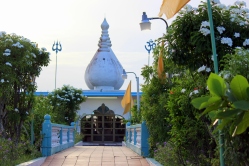This was my last day in Trinidad before heading back home to NYC. After Pitch Lake, it was time to continue exploring Trinidad. Next stop for the day was temple in the sea, then the huge 85 foot Hanuman statue.

Throughout the day, Wendell educated us on Trinidad’s history. Here is a brief version of it. African people were taken to Trinidad as slaves by the British and treated horribly, as we all know. Once they started to fight back and stop working, the plantation owners needed to get other people to work. So in 1845 they started bringing people from India to work on plantations. The only thing was, Indian slaves were told they only had to work for 5 years and at the end they would get their own land as compensation. Obviously, this was an insult to the African people who had worked a lot longer, treated much worse, and in return got nothing from the plantation owners. This created animosity between the African and Indian people

living in Trinidad. There wasn’t much integration between the two groups until very recently. Indian people live near each other and carry on traditions that are hundreds of years old. I think it’s because following old traditions is one of the ways they can hold on to their origins even after 150 years. Especially, since most of them have never visited India. Even though the communities did not integrate very much with each other until recently, most of them do not speak Hindi, Sanskrit or any other dialect from India. To this day, there are towns where majority of the population is of Indian descent. Of course, Wendell tells it in a much more poetic fashion.

By the time Wendell finished telling us the history, we had arrived at the Temple in the Sea. It’s a beautiful structure about 500 feet into the Gulf of Paria dedicated to Sewdass Sadhu. Obviously, Wendell told us history behind the temple as well. Sewdass wanted a place of worship but the plantation owners and the government at the time would not allow him to do so on private or state owned land. Sewdass decided he would build his temple in the sea because no one “owned” the sea. For over 25 years he would carry stones, rocks and dirt out to the sea and throw them in to create an island. Unfortunately, he died before he could complete construction of the island. In 1994, to commemorate the 150th anniversary of Indians coming to the country, government helped finish the temple and add a walk way for easy access.

By the time we made it to the temple, it had closed so I had to settle for walking around the temple and taking in the sights. One of those sights was many of these colorful flags around the temple (see picture above). Wendell told us that each color represents one deity. Black represents Kali and I cannot remember what gods the other colors represent. I learned that one of the traditions that Indians in Trinidad follow is putting one of these specific flags above their homes to identify which god the family worships. This was definitely one of those traditions that I had never heard of even  though I grew up in India. I also asked a few relatives about this tradition and no one seemed to know much about it. I supposed this may be a tradition from a region that my family is unfamiliar with or no one follows this tradition anymore.
though I grew up in India. I also asked a few relatives about this tradition and no one seemed to know much about it. I supposed this may be a tradition from a region that my family is unfamiliar with or no one follows this tradition anymore.
Just as it was time to move on to the huge Hanuman statue, I noticed two Four-Eyed Fish swimming in the water. I’m not a marine  biologist but I think they were mating. I watched them swim around for a few minutes before getting back in the car to head over to see the largest Hanuman statue outside India. While temple in the sea was small, simple and peaceful, the Dattatreya Temple was the opposite. It is large, bright, and extravagant. Personally, I did not like it very much. This is probably the only place in Trinidad that I did not enjoy at all.It wasn’t bad but it just wasn’t for me.
biologist but I think they were mating. I watched them swim around for a few minutes before getting back in the car to head over to see the largest Hanuman statue outside India. While temple in the sea was small, simple and peaceful, the Dattatreya Temple was the opposite. It is large, bright, and extravagant. Personally, I did not like it very much. This is probably the only place in Trinidad that I did not enjoy at all.It wasn’t bad but it just wasn’t for me.
For more pictures, please visit my Instagram page: Rupal’s Travel Diaries







I loved this part of your blog very much because it tells us many new things about history of Indians and Africans I have never heard before.
Very interesting to know about the will power and hardwork involved to built a place of worship 👍👍
Superb